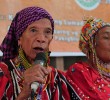Government repeatedly declares achievements by successive land and agrarian reform programs, including the CARP. How does this reconcile with decreasing land ownership according to agriculture census data?
By Sonny Africa
Ibon Features
MANILA — As the Comprehensive Agrarian Reform Program (CARP) marks its 18th anniversary this month, rural poverty continues to be widespread and millions of peasants still remain landless. And this is not just after close to 20 years of CARP, but nearly half a decade of various agrarian reform programs.
Major land reform legislation in the country started with the Agricultural Tenancy Act of 1954, the Land Reform Act of 1955 and the Agricultural Land Reform Code of 1963. Following the Agrarian Reform Code of 1971 and Presidential Decree No. 27 (PD 27) in 1972 under the Marcos regime, agrarian reform took organizational form with the creation of a Department of Agrarian Reform (DAR). Most recently, Republic Act (RA) 6657 or the Comprehensive Agrarian Reform Law (CARL) of 1988 initiated the CARP.
Yet, according to various Censuses of Agriculture, full land ownership has actually been on the decline since PD 27 was enacted. In 1971, 58% of all farms were fully owned but this fell to 47.5% in 2002; in terms of land area, fully owned farms accounted for 62.9% of total farm area in 1971 but fell to 50.6% in 2002.
Although there was a decrease in the share of completely tenanted and leased lands, this translated not into full ownership but rather only to part ownership that implies a continuation of tenancy and lease arrangements. In fact, the Annual Poverty Indicators Survey (APIS) of 2002 reported that only 11% of all families owning land other than their residence had obtained land through CARP.
Yet the government repeatedly declares achievements by successive land and agrarian reform programs including, most recently, the CARP. How does this reconcile with decreasing land ownership according to agriculture census data?
Pro-Landlord
Reports of government accomplishments certainly seem substantial when taken at face value. The DAR and the Department of Environment and Natural Resources (DENR) report a cumulative accomplishment of a seemingly impressive 6,404,559 hectares � or 79.4% of the target CARP scope of 8.06 million hectares � with 3,825,142 farmer beneficiaries over the 1972-June 2005 period. These figures seem to indicate that agrarian reform in the Philippines is well, if slowly, underway.
But it should be noted that the current target scope represents a severe downward adjustment from CARP�s original scope in 1988. Back then, the target for distribution was 10.3 million hectares, or some 85% of total agricultural land planted to crops and a third of the country�s total land area. However, this was adjusted downwards by 21.7% in 1996 to the current scope of 8.1 million hectares following drastic cuts in coverage of both private and public lands.
The reason behind these cuts highlights why CARP has so failed to make a dent in peasant landlessness: its pro-landlord orientation. At heart, CARP is not about free land distribution to the tiller, which is the core of a genuine land reform program, but about landlord compensation and requiring peasant beneficiaries to pay for land that they have been tilling for generations. Land reform under CARP is essentially a land transaction between landlords and peasants with the government acting as the middleman.
The revised CARP scope represents a concession to big private landed interests.� The target was adjusted downwards to accommodate CARP exemptions. CARP allows landlords to retain five (5) hectares of land and a further three (3) hectares for each of the heirs; PD No. 27 had a retention limit of seven (7) hectares each. Landlords used these as a loophole, hurriedly subdividing their landholdings and coming out with multiple titles within the limits. Yet the scope of exemptions even broadened far beyond just retention limits.
At least 60,000 hectares of land in commercial farms and plantations were exempted in the 1988-1998 period (and which remain undistributed even as the deferment period has expired). The Supreme Court handed down a decision in 1990 sparing commercial livestock, poultry and swine operations from CARP coverage. Belated land use conversion is also another way out where agricultural lands that have already been distributed are suddenly found to be, according to local land use plans or zoning ordinances, for residential, commercial or industrial use and hence CARP-exempt.
Further, landlords also had the option to forego land distribution altogether through non-land transfer schemes, such as the infamous Stock Distribution Option (SDO). The SDO substituted corporate stock sharing for land distribution to peasants; conversion to leasehold arrangements supposedly guaranteed that, in farms under 5 hectares, the split of net produce between landlord-tenant would be 25-75; and other production and profit-sharing arrangements.
In the end, the revised CARP scope in 1996 only covered 2,999,105 hectares of private land � which implies that some 43.7% of total potential landlord land for distribution of 5,328,172 hectares was outright exempted from CARP. The reductions in the scope of public land in turn accommodated vast tracts of government land leased or otherwise controlled by big landlords as cattle ranches, export crop plantations and logging concessions.
Trends in CARP implementation as reported also confirm its pro-landlord bias and a couple of examples can be highlighted. Most striking is that compulsory acquisition (CA) � covering the largest chunk of privately-owned land (including commercial farms and plantations) and the most resistant landlords � has the largest balance remaining among all land types. This is both in terms of absolute land area (1.3 million hectares) and as a percentage of its target scope (83.8%); it also accounts for the overwhelming majority of total balance remaining (76%).
The �over-performance� of voluntary land transfers (VLTs) by 82.8% is actually alarming. VLTs ostensibly provide for the direct transfer of land from landlords to the peasant beneficiaries with the government no longer acting as the buyer (from the landlord) and the seller (to the peasant) but responsible for mediating the transfer and subsequent enforcement of the contract. The use of this particular CARP mode of land redistribution is alarming because not only is the landlord in a strong position to dictate the terms of the contract with the peasant, the landlord is even in a position to use VLT as a deception where there is only a bogus �contract� and no transfer of land at all.
On top of all this, landlords have also profited immensely from CARP apart from what they had already accumulated through generations of land ownership. Total approved Land Bank of the Philippines compensation over the 1972-June 2005 period to 83,203 landowners for 1,348,758 hectares has already reached P41.6 billion in cash and bonds, or an average of P500,463 per landlord. A further P4.5 billion is budgeted for 2006.
Deceptive Accomplishments
The CARP�s reported accomplishments are also dubious since various forms of bogus land distribution bloat the figures. The �accomplishments� include lands with registered Certificates of Land Ownership Awards (CLOAs) but that still haven�t been turned over to tenants who are still paying for their amortization. There is double counting where �mother� or collective CLOAs and the �individual� CLOAs under these are both tallied. In the most brazen cases, there are CLOA holders who still do not occupy the land because of outright landlord resistance.
The numbers also include �encumbered� CLOAs prematurely released to beneficiaries for the sole purpose of padding reports. These CLOAs are stamped or otherwise annotated as �encumbered� because of unmet payments and documentary requirements and do not yet give holders the same rights of ownership as regular CLOAs. Land has also been reported as distributed but in reality is inalienable or otherwise not suited for agricultural production.
Apart from reporting dubious accomplishments, these reports also do not reflect the distressing amount of reversals occurring for a variety of reasons. CLOAs and their equivalent under PD No. 27, Emancipation Patents (EPs), have been cancelled and land taken away from beneficiaries. Landlords and rural elites exploit a legal defect of CLOAs and EPs that limits the security of beneficiaries� claim to the land covered: Torrens Titles have a one-year prescriptive period for bringing up cases against them as opposed to CLOAs and EPs that have no such limit.
This gives landlords the legal opening to reclaim land by disputing the redistribution of land. CARP exemptions are used, belatedly, as the basis for cancellations. They also maneuver decisions favorable to them through technicalities including supposed errors in data entries, in the change of documents from EPs to CLOAs, and in the identification of legitimate farmer beneficiaries.
These defects, loopholes, and outright corruption have resulted in thousands of cancellations through the years. Over 2,000 CLOAs and EPs covering over 380,000 hectares of land and thousands of peasant families had been cancelled by mid-2004, including EPs distributed over two decades ago. This is likely to be a gross underestimation though because DAR officials themselves admit that there is no nationwide mechanism in place to monitor reversals happening on the ground. Land conversion has also caused total farm area to fall to 9,670,793 hectares in 2002, or 304,078 hectares less than in 1991. This figure does not include land that has been �converted� on paper for the sake of landlord expediency.
In addition, there are also land distribution reversals resulting from the economic pressures on peasant beneficiaries. Beneficiaries are hard-pressed to make the lands distributed to them productive because there are no support and extension services available to them. This comes on top of the generally unfavorable economic environment due to rapid agricultural sector liberalization in the 1990s and the dumping locally of cheap cereals, spices and vegetables from abroad. Falling farm incomes and mounting debt drive peasants to stop amortizing �their� land leading either to foreclosure, a sale of the land back to the landlord (who continues the payments), or out-and-out abandonment.
CARP accomplishment reports then do not reflect the hundreds of thousands of hectares of land that �beneficiaries� are losing back to landlords, commercial and real estate developers. In any case it seems that not all 2.1 million DAR CARP beneficiaries hold either EPs or CLOAs with only 1.7 million EP and CLOA holders as of December 2004.
Poverty and landlessness
The clear failure of land reform in the country has severe consequences for a predominantly agricultural country like the Philippines. The peasantry who make up the largest part of the population continue to be ruthlessly exploited by rural land, credit, trading and marketing monopolies and are kept in miserable poverty. Rural poverty incidence is two-and-a-half times that in urban areas and 73% of the country�s poor live in agriculture-dependent rural areas.
Land rent is still common with tenants paying anywhere from 30% to, in some extreme cases, as much 90% of their produce to landlords. The tersyuhan arrangement of a two-thirds share to the landlord and one-third to the tenant, which happens in many coconut farms in the Bicol region, is among the most common.
Farmworkers are doubly burdened with irregular work and, even when there�s work to be found, low earnings. Agricultural daily minimum wages ranged from P151-P212 nationwide yet farmworker wages were found to go as low as P20 (Negros), P50 (Samar), and P69 (Cagayan Valley). Peasants meanwhile have to contend with traders charging high prices for agricultural inputs like fertilizers and pesticides, while paying low prices for peasant produce.
With peasant incomes perpetually falling far below their needs, usury�s grip is deep with interest rates reaching the equivalent of 20% per month, 200% per harvest and 400% per year. In the province of Mindoro Oriental, P1,000 peso loans have been charged interest of four (4) sacks of rice, or equivalent to over four times the original loan amount.
CARP can not address peasant poverty and landlessness because it was never meant to. Thus, the only hope for genuine land reform in the country lies with the growing peasant movement. Organized peasant groups have directly confronted exploitation by landlords and traders. They have improved their livelihoods and welfare in ways that, unlike CARP, do not sidestep the issue of who should be benefiting from tilling and working the land. (Ibon Features)










